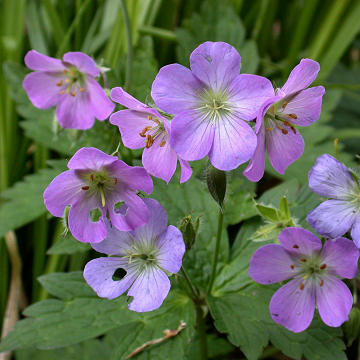

Geranium maculatum - (image 1 of 7)
Taxonomy
Family: Geraniaceae
Habitat
Woodland and savanna. Occasionally in prairies. Adapted to disturbance.
Associates
Found in woods with Acer saccharum, Cornus racemosa, Fraxinus americana, Ostrya virginiana, Prunus serotina, Prunus virginiana, Quercus alba, Quercus rubra, Sambucus canadensis, Tilia americana, Ulmus americana, Ulmus rubra, Vitis riparia. Herbaceous associates include Carex blanda, Carex hirtifolia, Carex pensylvanica, Carex rosea, Claytonia virginica, Cryptotaenia canadensis, Galium aparine, Galium concinnum, Hyprophyllum virginianum, Osmorhiza claytonii, Phlox divaricata, Podophyllum peltatum, Polygonatum canaliculatum, Smilacina racemosa, Trillium recurvatum, Viola sororia.
Distribution
The Dakotas south to OK and east to the Atlantic, excluding FL.
Morphology
Herbaceous perennial to 2' high. Leaves 4-5" wide, deeply 5-lobed, both basal and branching, the basal ones with long petioles. Flowers pink or lavender, petals and sepals 5, stamens 10, pistil 1, in loose clusters of 2-5 at the ends of branches from a pair of leaves. Fruit an elongated, beaked capsule containing 5 brown-black seeds.
Notes
Flowers early April to mid July
Wetland indicator: Facultative upland. Upland in the rest of it's range
A native and hardy geranium. Easily transplanted. Many of the wild geraniums are also called cranesbills for the shape of the pistil and calyx when mature.
Bibliography
Niering, W. A. 1979. The Audubon society field guide to North American
wildflowers: eastern region.
Knopf/Random House, New York.
Swink, F. and G. Wilhelm. 1994. Plants of the Chicago Region.
Indiana Academy of Science. The Morton Arboretum. Lisle, Illinois.
USDA, NRCS. 2002.
The PLANTS Database, Version 3.5 (http://plants.usda.gov).
National Plant Data Center, Baton Rouge, LA 70874-4490 USA.
|
Michael Hough © 2004 |